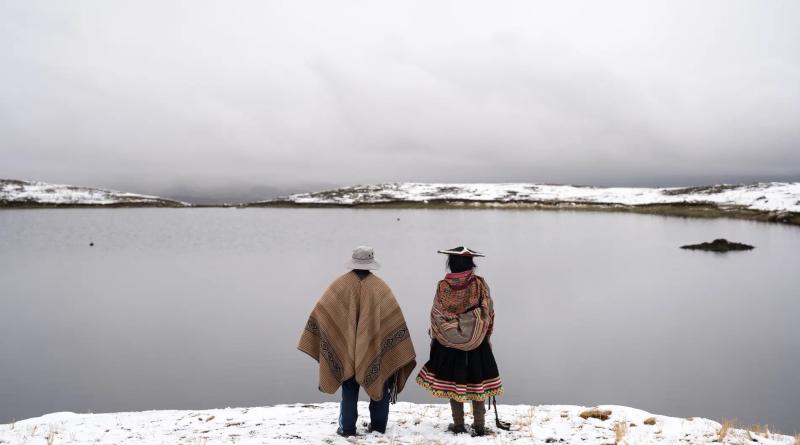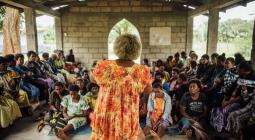‘Without the ice cap, we cannot live’: the Andes community devastated by climate crisis

As the turquoise lake at the foot of the Quelccaya glacier comes into view, Yolanda Quispe stops to look. She is sure more ice has melted since her last visit a few weeks ago. When Quispe, a park ranger, was born in 1982, Quelccaya, in the central Andes of Peru, was the world’s largest tropical ice cap.
Forty years on, it has almost halved in size, and been eclipsed as the world’s largest by Coropuna, also in the Peruvian Andes. A recent study suggests it might soon disappear. “It makes me very sad. Quelccaya is like a father, a mother to me. To protect it is an honour,” she says.
As the climate crisis takes hold and the ice cap melts, the lives of Quispe and her community in Phinaya are changing irrevocably.
“The ice cap is important for everyone – for those who live in Cusco, for those who are here in Phinaya,” says Quispe. “Without the ice cap, without water, we cannot live. It will affect, above all, our children and grandchildren. It is they who will be affected the most by climate change.”
At almost 5,000m above sea level, it is impossible to grow even the most resistant tuber. So, the 200 families who live in Phinaya look after alpacas. Every kilo of potatoes or salt is bought with the proceeds made from the sale of alpaca fleeces. Now, this too is under threat.
Hundreds of hectares of grasslands are drying out, just like the area’s water reserves.
Twenty years ago, Quispe’s family owned 1,000 alpacas. Now they have just 205. “Looking after alpacas is more and more difficult because of the climate – the intense cold here, the lack of rain and the scarcity of pastures,” she says. During a mega-drought that hit the region in 2021, 60 of her alpacas died and a dozen females miscarried.
Salomé Huillca, 61, who lives in Phinaya, also sees the change in frequency and intensity of rains, snow and winds. “Before, we had water, the snow-capped peaks were fine, the rain was also different and there wasn’t hail,” he says.
Huillca has seven children, only one still lives with him and his wife in Phinaya. “Sometimes I worry because my children aren’t here. It’s only us parents who are here experiencing the cold and the rain. I would like them to return, but they don’t want to … if there was work they wouldn’t have left. They would still be here,” he says.
His family is one of the few in Phinaya that didn’t lose any alpacas in the drought. For more than three decades, he has harvested rainwater, funnelling and storing it in small lakes, or qochas. “In my lakes, there is water and for this I am happy. If not I would have nowhere to take my animals because there isn’t water anywhere. It’s always dry now. If there is no water, the animals are sad,” he says.
Domitila Cono is following in Huillca’s footsteps. “The majority of us are thinking of, or are already, harvesting rainwater. Because if we don’t do it, how will we be able to continue? We have to adapt to climate change,” she says.
The park ranger hopes saving the water will prove helpful in the future. In 2021, she says she couldn’t move her alpacas for grazing. The rains that normally start in August or September came in the middle of December by which time the land had dried up. Of the 10 springs in the area, only a couple remained. “In the town, we have a reservoir that serves the population. That year it diminished so much we had to restrict its usage. There were days we had no water,” she says.
Cono, 30, thinks harvesting rainwater is one solution, but she wants to return to the way her ancestors lived. She remembers how her grandmother gave offerings of thanks to the springs and the mountains. “They had a lot of belief in the land, a lot of care for Mother Earth. The latest generation doesn’t practise this any more. It would be good to get that respect back among the young,” she says.
Migration from the Andes to the cities, usually Lima, has occurred for decades in Peru. But the changing environment is now the main cause of population displacement in Phinaya, according to Rafaela Mattos, a Brazilian researcher.A study by Mattos showed that in the past 10 years, increasing numbers of young people have migrated to the cities of Sicuani, Cusco, Arequipa and Puno. “Among other factors, climate change means that alpaca farming is no longer profitable. The changes affect the grass, the water, the alpacas. Therefore the principal activity is not attractive enough for the young to stay,” she says.
If the situation continues, the current Phinaya herdsmen could be the last. “The depopulation is worrying principally because it could mean new mines and the increase in conflict, violence, poverty and degradation of the environment,” she says in her study.
“My children, my nieces and nephews don’t want to be here,” says Quispe. “I tell them, ‘this is our life and we have to carry on’. The day we die, the grasslands will be alone and our houses abandoned.”Faced with this looming fate, in 2019 the community of Phinaya decided to join the Regional Conservation Area of Ausangate, which covers 66,500 hectares (164,000 acres) and has a mission to protect the fragile ecosystems in the Vilcanota mountain range. The area’s snow-capped peaks, wetlands, lakes and shrublands are home to the region’s rich variety of animal, bird and plant life.
“With the conservation area, we are trying to generate tourism so that the young return. Belonging to a conservation area protects us from mining. It’s because of this we chose to be part of it,” says Quispe.
Huillca has built two rooms on his land to host visitors. The rooms are painted green, and coats, hats and bags made of alpaca fleece are hung on the walls, woven by his daughter, Yovana, who is studying nursing in Arequipa.
cover photo: Photographs by Ángela Ponce





